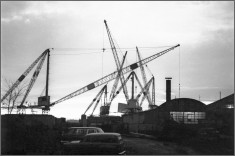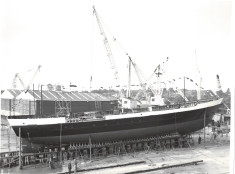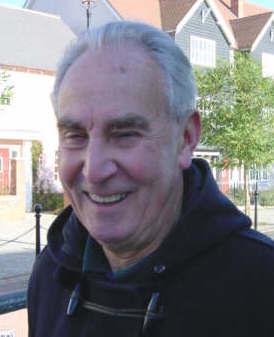‘HERE YESTERDAY AND GONE TODAY’
Note: This aricle was writen by Bill Ellis in 2003 and was first published in the Wivenhoe Encyclopedia. Readers should bear in mind the date this article was written, especially if they are presently living on the Cooks Development. Bill is sadly no longer with us, having passed away in October 2012. Peter Hill.
In the current era when ‘here today and gone tomorrow’ seems the norm it is, perhaps, interesting to reflect on what was here yesterday and gone today. Many sea and riverside sites around the U.K. have seen great changes in recent decades. Ship and boat building and repair yards, many of considerable antiquity, have gone – probably forever – to be replaced by other developments.
The villages of Wivenhoe and Rowhedge in Essex have witnessed such changes. Situated on the tidal reach banks of the River Colne a couple of miles downstream from Colchester/Camulodunum, England’s oldest recorded town, maritime activity of one sort or another had been carried on in the area from very early times. In A.D.43 Roman Emperor Claudius came on the scene with a number of elephants and his Legions led by General Aulus Plautius. In due course these conquerors established a supply base on the southern bank of the river facing across to the Wivenhoe site.
Wivenhoe, a Roman Port
Corbita, the substantial trading vessels of the period, could not progress upstream as far as the Fort and Colonia established by the 20th Legion at Colchester. In consequence the Wivenhoe and Rowhedge reaches served as the ‘outport’. The local gravely spits of land enabled visiting vessels to be careened for repair and building work to be carried out.
By the Middle Ages ‘out-port’ and construction/repair activity seems to have become well established. During the last four centuries such activity became concentrated on 3 main sites, one at Rowhedge and two at Wivenhoe. A wide variety of trading ships, fishing craft, warships and all sorts of specialised vessels, even the ‘odd’ submarine were built or repaired.
Shipbuilding ceased in 1986
However, within the last 20 years all three yards have ceased to carry out their long established roles. The Rowhedge and the oldest ‘historic’ Wivenhoe shipyard sites are now residential estates. The ‘downstream’ site at Wivenhoe, derelict since 1986, will shortly have a mainly residential development started where once ships were built and launched. At this site real shipyard work did not start until about 1840. For the following century mostly small craft were built mainly by the Husk family.
The War Years and post WWII
In the early years of the 1939/45 war Vosper Ltd., took over the yard as a ‘shadow’ facility for the building of Motor Torpedo Boats and the repair of various coastal forces craft. At the end of the conflict Vosper no longer needed the extra capacity and left leaving an expanded yard which had a large shed with 4 slipways plus a further covered slip for larger vessels and a wet berthing basin. The next 40 years would see a rise and decline of activity on the site rather typical of many other instances around the country.
James W. Cook & Company Ltd., a London based organisation founded in the mid 19th century operated as wharfingers and lightermen on the Thames. The company also built barges and repaired tugs etc., at Orchard Wharf. In addition they had diversified into general haulage, garage ownership and building work. A subsidiary company The Bulk Oil Steamship Company operated a number of tankers – the ‘Pass’ ships. Cooks Thames side installations being unable to cope with all their requirements, the ‘Pass’ ships went to Wivenhoe Shipyard Ltd., the very long established ‘up river’ yard, which had a fine dry dock built by Forrest in 1888. Seeing the ‘downstream’ yard vacant and for sale Cooks decided to buy it. This purchase plus 10 acres of adjoining land was completed in March 1947. To operate the yard a new company James W. Cook & Co., (Wivenhoe) Ltd., was incorporated in January 1948.
At first only Cook Group work was handled. Barge and tug repair jobs plus maintenance of the Bulk Oil Steamship tankers. Then some building of motor tank barges, small tugs and a mixture of other barges and lighters – some for another Cooks subsidiary Wiles Lighterage Company – was undertaken. A few small boats and yachts were also constructed during this period. Soon it was realised that capacity was sufficient for outside work to be taken on.
The Festival of Britain was in course of preparation and the London County Council placed an order with Cooks of Wivenhoe for floating pontoons. These were installed at Battersea Gardens and the Royal Festival Hall in 1951. An ever-increasing number of orders for a mixture of craft followed. Some were for the U.K. but others for the Middle and Far East.
Wm. Cory & Son take over Cooks
Wm. Cory & Son Ltd., ordered a Diesel Station Tug ‘Regard’. She was launched on 28th July 1958. This little ship must have pleased the Cory management for later the same year they took over the Cook Group. In the subsequent restructuring the Wivenhoe arm emerged as the only recognisable unit bearing the ‘Cook’ name. Under the General Management of Mr. A.G. Smith (see picture)

Mr A G Smith, General Manager, James W Cook
and Yard Manager, Mr. Frank Hodgson, the enterprise progressively expanded. The 10 acres of adjoining marshy land were consolidated with material emanating from the site being developed about 2 miles away for the building of the University of Essex. In due course the yard facilities comprised five slipways, eight building berths (4 under cover), a two hundred feet long fitting out basin and a variety of cranes including one with a fifty ton lift.
Throughout the ‘60s a steady stream of coasting vessels, dredgers, tugs, pilot boats and all sorts of barges and lighters took to the water from the Colne side slipways. Quite a number were destined for foreign parts including the Falkland Islands.
With the expanded capacity available to company developed the process of using flat strakes of hull plating wherever practicable. This practice resulted in the ‘Colne’ class of casting vessels being built. The first M.V. Moler Venture was completed on 3rd November 1972. This 940dwt 189-foot long ship went to work carrying refractory bricks from the continent to the works of Moler Products Limited, at Colchester. (Note: See additional text below contributed by Phil Vandersteen who, as a an engineer at the Yard, was asked to accompany the MV Moler Venture on her maiden voyage.)
Being in fashion this riverside wharf is currently being redeveloped with residential flats, student accommodation for the University and a large restaurant complex.
Cooks changes hands again
Other events of note during 1972 were bids for the company group by Jessel Securities and Court Line. However, The Ocean Steamship Company eventually won the day and took over ‘Cooks of Wivenhoe’.
During the years 1966 and 1967 the number of vessels of all types built reached a total of 56. These were mainly fairly small craft for the yard’s potential. During the following decade ships of increasing size largely based on the ‘Colne class design left the slips. J & A. Gardner of Glasgow commissioned 5 coasters of varying configurations 3 being ro-ro ships. Another order from north of the border was from Peacock Salt Company, for the 1665dwt vessel ‘Peacock Venture’. Among other U.K. customers were Onesimus Dorey & Sons Ltd., for 3 cargo vessels; Spillers – 4 coasters; Crescent Shipping – 7 coasters, and Manchester Ship Canal – 4 tugs. The rest of the world joined the order book for ‘Cooks’ built vessels. 2 fishing vessels made their way to Bangladesh, a pair of passenger/cargo craft went to the Solomon Islands and various Middle Eastern and African buyers were catered for. With over 120 directly employed staff ‘Cooks’ had become the major employer in a small community and the ‘Shipyard’ was held in considerable respect, and indeed affection, by the local population.
Public were invited to ship launches
On launch days of major contracts, parties of children from the local schools attended to experience and enjoy the ‘christening’ ceremonies performed by assorted dignitaries. Organisations in the town were quietly helped in many ways. To supplement actual new building work, repair jobs were also undertaken in the earlier years.
Unfortunately from the mid-70s the order book began to progressively thin down. However, in 1981 an order was received for two specialised cattle carriers – M.Vs ‘Buffalo Express’ and ‘Zebu Express’ – from Dutch company Vroon B.V. Each was arranged to carry 740 live animals on three decks. The 66 metre long vessels were required to meet Lloyds, Netherlands Shipping Inspectorate, Australian D.O.T. classifications and incorporated sophisticated air conditioning heating, feeding and waste disposal requirements. The ships were respectively completed in June 1983 and February 1984.
Although both ships were technically satisfactory other problems arose. These resulted in Ocean Steamship contemplating closing down the yard in March 1984. Energy and Marine Industries then purchased the business.
Shortly after this two substantial orders were gained. The first was for 36 dumb barges required by Wm. Cory for London waste disposal work. The steel for these was brought in, cut and shaped, from Hungary by road transport.
The STS Lord Nelson and Voluntary Liquidation
The Jubilee Sailing Trust then ordered the building of the 175 foot steel Sail Training barque ‘Lord Nelson’ designed to enable people with disabilities to experience crewing at sea. In addition a tug and five barges were ordered by Pass International for service in Ghana and the P.L.A. ordered a driftwood vessel.
Then what sadly proved to be the last order for a vessel to be built at ‘Cooks’ arrived. It was the Northern Ireland Fishery Harbour Authority for a hopper dredger to be called ‘Kilmourne’.
Despite the fact that the Prince Andrew was on hand for the keel laying and Lady Violet Aitken performed the launching ceremony of ‘Lord Nelson’ the contract experienced difficulties. The Cory order also ran into problems. In April 1986 James W. Cook & Co. (Wivenhoe) Ltd., went into voluntary liquidation.
On May 26th 1986 ‘Lord Nelson’ left the Colne under tow by T.S.A. Tugs Ltd., ‘Towing Wizard’ with Felixstowe tug ‘Gray Echo’ standing by for her initial ‘voyage’ to the Vosper Thorneycroft yard at Woolston, Southampton. There the barque, which when the keel was laid was heralded as the first large sailing vessel built in a British yard for 75 years, was christened by Miss Sarah Ferguson on July 4th.
The dredger ‘Kilmourne’ was launched by Mr. Frank Ledwidge, Chairman of N.I.F.H.A. on 24th July and completed in August 1986 bringing to an end 39 years of shipbuilding/repair work by Cooks on the Wivenhoe yard site.
512 Vessels built since 1947
Since 1947, 512 vessels of all types had been built. The first was yard Number 1001 motor tug ‘Cloudy’ and the last yard number 1515 allocated to the Pass International tug destined for Ghana, Numbers 1050, 1174 and 1175 were not used.
On 16th December the sale by auction of all yard plant and equipment took place. The Liquidator Mr. Martin Spencer of Messrs. Casson Beckman proved to be most kind and co-operative to those wishing to preserve as much as possible of the last of the long local maritime heritage for posterity.
In fact Mr. Spencer expressed considerable pleasure that there was such local interest. It seems that during wide experience in his profession he had often been disappointed to find that no great efforts were made to save irreplaceable plans, records and the like. Happily in the case of Cooks, virtually 100% of the plans and records went to Essex Record Office and the half models, photographs and other artefacts lodged with a small local museum, the Nottage Maritime Institute.
For the last 16 years the site which saw so many happy, productive days has lain sadly derelict, deserted and regrettably not immune from vandals and fire raising activity which destroyed a pair of listed buildings.
The Tidal Surge Barrier
In 1991, a Tidal Surge Barrier was constructed across the River Colne from the Wivenhoe (ex Cooks) site to the Fingringhoe shore. Together with control and machinery rooms for the Barrier, which it is hoped will prevent any local recurrence of the 1953 disaster, an office for Colchester Harbour Master was provided. Wivenhoe Sailing Club benefited from the scheme. A smart new Club House with hard and other facilities was provided just the seaward side of the Barrier although the Club continues to have use of the historic ‘town hard’ in the centre of Wivenhoe waterfront.
Commercial traffic up to Colchester Hythe and the wharves at Rowhedge and Wivenhoe had so declined by 1999 that continuance of Colchester as a Port was no longer viable. On 14th April 1999, M.V. ‘Ruhrort’ of Duisburg brought the last cargo up the River Colne to Rowhedge Quay.
Closure of the Harbour
In 2001 the Harbour was closed by Act of Parliament.
So nearly 2000 years after the troops of the 20th ‘Valeria’ Legion handled their cargoes of wine, other goodies and stores while their comrades serviced the Roman ships the River Colne fell silent. The only maritime activity, apart from a small number of inshore fishing craft, to enliven the scene had become virtually entirely leisure and pleasure based.
After the customary meetings, enquiries and sundry planning discussions development of the ex Husk//Vosper/Cooks shipyard site seems imminent in 2003. A mixture of residential dwellings, small business premises and public toilet facilities are envisaged.

Bill Ellis who died in 2012
The local inshore fishing community will be catered for with berthing provided. Taking account of the very attractive riverside setting, rural outlook and one hour (on a good day!) – rail connection to the heart of the City of London an expansion of the steadily growing commuter population is confidently expected. One can only speculate on just how long it will be before the days of ships on slips are forgotten except by the present ageing locals who will surely remember yesterday.
Bill Ellis
Written and first published January 2003
See also:
Bill Ellis’s models of boats built at Wivenhoe – click here
About Bill Ellis – A eulogy and an obituary – click here
To see photographs of Cook’s Shipyard under construction – click here
For recent developments on Cook’s Shipyard – click here
The following text was written by Phil Vandersteen about Frank Hodgson
When the Moler Venture was built and ready to go to sea, I had the chance to sail on her.
Mr Hodgson called me into his office. I thought, blimey, what have I done wrong. So nervously I went and he asked if I would like to sail on the Moler Venture.
He gave me a long chat about being abroad, and about the life in the merchant navy, and to be careful when I was out and about as I would see things I had never seen before. He spoke to me just like a dad would to his son, (I was 20 years old and never been anywhere).
His words remained with me every time we went ashore. I did thank him some years later. He said my main role would be to make sure the Chief Engineer was checking and changing the filters etc and, if not, I would have to do them. This I ended up doing because the Chief Engineer thought being a new ship he wasn’t going to do anything. These filters needed to be done on a regular basis as everything was new. Also the Chief Engineer was a lazy man, as far as he was concerned; it wasn’t his responsibility to look after the engines or any of the other equipment, as they were under guarantee.
I sailed on her for some time until they eventually got another Chief Engineer. I then returned back to the yard.
I have worked in many places but I have never seen workers have so much respect for a General Manager and Yard Manager (Mr Smith and Mr Hodgson). They were ‘old school’ and they earned respect.
Even now (and I’m 63 now) when referring to Mr Hodgson I would not dream of calling by his first name. I owe so much to that man for that chat in his office.
Although I have always lived in Colchester I have always thought of Wivenhoe as my second home. I had some great times there.
Phil Vandersteen – 5th July 2016






Comments about this page
I worked at the ship yard, and it was the best place I have ever worked. The men that worked there had so much skill; Mr Smith and Mr Hodgson had respect from all who worked there, they were in my opinion true gentlemen. It’s a great shame that the yard has gone.
Note: Frank Hodgson lived a long life after retirement from Cook’s. He died in 2016 aged 90+. I last saw him in 2015 riding his bike and he stopped for a chat with me. He was a keen member of the Wivenhoe Bowls Club and I think President. He was indeed a lovely gentleman. Peter Hill
Add a comment about this page